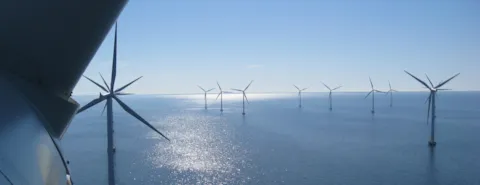State Permitting: Implications to offshore wind project success in the United States
Competency in permitting of complex, large-scale energy projects within state and municipal jurisdictions is becoming increasingly important in the United States. In recent months, DNV has seen a surge of inquiries from regulators and customers about how to navigate these essential aspects of offshore wind projects.
As our nation begins placing more turbines in the water, equally critical to the success of the industry is upgrading onshore infrastructure to ensure it is capable of supporting offshore generation. Each coastal state has a role in leading the charge—and DNV is supporting our customers’ success through our permitting and engineering competencies, backed by our 30 years of leadership in offshore wind.
Although much attention and excitement within the offshore wind space currently surrounds the nation’s first implementations of wind turbine and substructure technologies, the priority and role of each states’ initiatives are also necessary to be kept top-of-mind. There are many prospects for onshore developments along the coast from transmission lines and substations to ports and manufacturing facilities. Effective permitting of these onshore upgrades is critical for distribution to the grid and, arguably, the overall success of offshore wind’s part of the Energy Transition.
The federal processes for offshore wind approvals are extensive and intertwined; however, potentially even more challenging to navigate are the variations in processes, permits, jurisdictions, and the layering of requirements needed for approval of onshore project activities. Through project experiences managing early stage planning, risk assessments, and permit applications across the country—inclusive of the offshore wind focused states of California, Connecticut, Louisiana, Maine, Massachusetts, New Jersey, New York, Oregon, Rhode Island, Texas, and Virginia—it has become apparent to me that state and local processes are incredibly effective in ensuring the best possible outcome for all stakeholders, while minimizing impacts to valued and sensitive resources.
To facilitate and put into action the evolving policies and technical requirements of the states, consultants and developers need to be increasingly agile. As an environmental and permitting professional for the past 15 years, I have witnessed the permitting-engineering complexity and need for solutions firsthand. Appropriate planning enables efficiency in the very complex processes associated with both state and local permitting. This includes not only complying with coastal and terrestrial regulations, but also proactively engaging stakeholders. These planning and permitting efforts also complement my team’s extensive transmission, cable routing, and engineering experiences—bridging the gap or disconnect between these two disciplines.
To benefit the industry, several states have been creating programs in an effort to streamline their processes, clarify permitting and technical requirements, limit the review periods, and incentivize developments. We have also seen investment by the states to facilitate growth of the industry and to drive them toward success in achieving their individual renewable goals. A few examples of this include Rhode Island’s Strategic Plan for Offshore Wind Jobs & Investment, New York’s 10-step Initiative, and aggressive transmission planning investments made by both New Jersey and California. As the states are turning their focus to supporting and funding onshore developments related to offshore wind generation, I wanted to share some general insights based on my experiences:
- Be proactive and informed – Look at the policies across states and follow industry updates being released by the different state agencies (such as the CEC, ME Governor’s Energy Office (GEO), New York State Energy Research & Development Authority (NYSERDA), New Jersey Economic Development Authority (NJEDA), as well as the environmental agencies, including New York State Department of Environmental Conservation (NYSDEC), New Jersey Department of Environmental Protection (NJDEP), Massachusetts Department of Environmental Protection (MA DEP), Connecticut Department of Energy and Environmental Protection (CT DEEP), and Rhode Island Department of Environmental Management (RIDEM)). All these agencies will ultimately approve or deny the very necessary permits associated with all of these developments. Not obtaining these approvals jeopardizes the entire offshore wind project’s success.
- Engage early – Communication and transparency with the agencies and impacted stakeholders (local and tribal communities) is vital as large-scale energy projects have long been controversial. This step is critical and growing in importance. Work with the agencies to clearly identify the ultimate goal and benefits of the project, while addressing issues the stakeholders are most concerned with.
- Be proactive and collaborate – Ask the tough questions, understand what each individual state cares about most and prioritizes, and find out what the expectations are in terms of studies or engineering design accommodations. Collaboration with the agencies leads to the best possible outcome for these projects.
Working with the local, state, and federal agencies has given me perspective on the creation of efficient and effective permit applications and an even greater appreciation for collaboration. There is no shortage of activity ahead for the offshore wind industry—with the planned onshore transmission investments and solicitations, progression of developments within the New York Bight, increasing number of turbines in the water, and lease auctions anticipated—and the states are at the center of it.
Understanding that permitting is marbled throughout the entire project lifecycle and accurately accounting for the effort and overlapping schedules surrounding applications, consultations, reviews, and approvals, is critical. Development of a strong project plan, inclusive of a coordinated approach to permitting and project design is, therefore, essential—without this investment, and recognition of the individuality of the states and local communities, any project will be hard pressed to succeed and enter those aspired for construction and operational phases.
3/27/2024 2:00:00 PM
